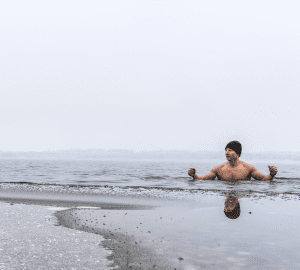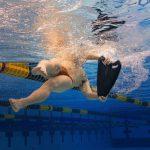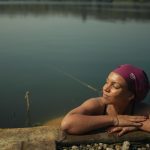Keep something up your sleeve (or down your trunks)
When you talk to top level open water swimmers, a common theme is that every race is different and the more experience you can accumulate of racing scenarios, the better you will race. This is one of the reasons (as well as incredible hard work and talent) that certain long distance swimmers, such as Thomas Lurz and Angela Maurer, continue to compete at the highest level well into their mid and late 30s.
Experience is also useful at the amateur level most of us swim at. Last weekend I took part in Chillswim’s Length of Coniston swim, a 5.25 mile splash up one of England’s most scenic lakes.
At the beginning of the race I saw Paul Bates stuffing an energy gel into his swimming trunks. I asked him why (apart from vanity) he would do that when there were four feed stations along the route.
“You never know what might happen out there. It’s best to be prepared,” he said.
I was wearing a wetsuit and he suggested I slide a gel inside a sleeve or the leg of the suit, but I didn’t see the need.
Once the swim was underway I found myself swimming behind and stealing a draft from two other swimmers. I knew one of these swimmers – Dion Harrison – to be usually much quicker than me but drafting really does allow you to swim much faster than your usual pace so I was able to keep up (and Dion later admitted he struggled a bit to get going in the first part of the swim). The second swimmer was Steve Taylor, someone I used to swim with 35 years ago at Cheltenham Swimming and Water Polo Club.
The first feed station, at 1.5 miles, was set some distance away from the line being followed by Dion and Steve. They chose not to stop and I didn’t want to lose the draft so I continued, thinking they would probably stop at the second station, at 2.5 miles. As we came close to the marker for that feed station it became clear that they were again going to take a wide line and again not stop. At this stage I felt fine and probably could have continued drafting but was also concerned about not eating anything since insufficient nutrition had probably played a significant part in what had happened to me the week before at Windermere.
I didn’t take long over the feed but the time dropped in diverting to the feed station was enough to open up a gap that, as I’d lost the draft, I wasn’t able to regain. So, despite being level with Dion and Steve at half way, I eventually finished several minutes down.
Whether having a gel up my sleeve would have made a difference to the final result is impossible to tell but at least it would have given me more tactical options. Firstly, I could have confidently swum past the feed stations knowing I had my own supplies available if needed and, secondly, I could possibly have taken a quick feed without losing the draft.
Sorry Paul, I should have taken your advice. (Incidentally, Paul won his age category in the non-wetsuit event.)
The other thing I saw at Coniston was the impact of not eating. For much of the race I was swimming near Dan Abel, and I’m sure he won’t mind me sharing this story. Dan is a much faster swimmer than me, but I was wearing a wetsuit and he wasn’t, which puts us at a similar pace (I estimate I’m gaining about 7-11 seconds per 100m with a wetsuit). Several times during the first part of the race Dan and I were swimming shoulder to shoulder. At 3.5 miles I stopped for a quick energy drink at the feed station. Dan continued without stopping and gained a few metres on me, which I soon caught up again. We continued to swim alongside each other until shortly after the four mile marker when I pulled ahead.
At 4.5 miles I stopped for a gel at the final feed station and then swam hard to the finish. Dan finished nearly 4 minutes behind me, all of which was lost in the last mile. The first thing he said when he crossed the line was, “I need sugar!”
He later explained that he liked to experiment with things during swims and was curious to see how he’d cope with not eating. He admitted he was suffering over the final stretch.
Dan still won the non-wetsuit category, but did he blow the chance of winning the overall title and the Suunto GPS watch prize? Non-wetsuit swimmers received a five-minute time boost under Chillswim Coniston rules to try to level out the wetsuit advantage. Dan finished 9:25 behind Dion Harrison, the first place wetsuit swimmer. With the five minute time penalty, plus the four minutes or so he dropped over the last mile, it might have been very close.
Speculation doesn’t change the final results of course. Both Dan and I made tactical errors that possibly added minutes to our time but that’s one of the exciting things about longer distance open water racing. Once a race goes beyond an hour, nutrition becomes increasingly important and it might be worth keeping something up your sleeve or inside your trunks to give you more tactical options.






